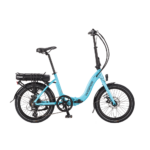This is what I did to deal with a failing battery. I am 71 and happy with the Swytch kit, which used to give me over 25 miles assistance at level 1, but lately not reliable above 20 miles. The Swytch battery is 36v,5Ah capacity. I bought a Yose36v, 13Ah for frame fitting. The Swytch battery and motor controller is removed from the bag, and the battery unplugged by pulling out the yellow connector. I kept the bag in place for tool storage. The motor controller went back into the bag, and a stiff insert in the bag lid to support the control pad. Red and black wires were attached to the corresponding wires from the motor controller, and passed through a hole in the bottom of the bag - I used a choc block electrical connector for convenience, and you will need 500mm of wire at least of the gauge coming from the new battery. I found the Yose battery frame did not fit where I wanted it, so I fitted 3 additional 5mm rivnuts in the cycle frame to suit, leaving clearance for the battery to be removed ( I wanted to keep a bottlecage on the seat tube). Then I fitted automotive crimp connectors to the free wire ends - these mate with the Yose output connectors That's it. The weight penalty is about 1 Kg.
The Swytch motor controller doesn't know the battery has a larger capacity, and works as before. Now, at the end of a 25 mile ride the Swytch pad still shows 4 bars capacity (out of 5), so I have a huge reserve which will help as the new battery inevitably degrades over time. I doubt I shall need more than 35 miles range. More usefully, the old battery would give progressively less assistance as it reached end of range, whereas the replacement does not behave this way because capacity is so much greater.
A very successful adaptation in my opinion , and good value for my needs.
The Swytch motor controller doesn't know the battery has a larger capacity, and works as before. Now, at the end of a 25 mile ride the Swytch pad still shows 4 bars capacity (out of 5), so I have a huge reserve which will help as the new battery inevitably degrades over time. I doubt I shall need more than 35 miles range. More usefully, the old battery would give progressively less assistance as it reached end of range, whereas the replacement does not behave this way because capacity is so much greater.
A very successful adaptation in my opinion , and good value for my needs.






